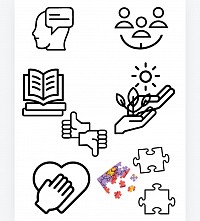SHOP FOR FREE
THE DYNAMICS OF EXPERIENCE
10 Aspects of daily life to meet up with everyday
Vital aspects of daily life for humans encompass the foundational activities and needs that ensure physical health, mental well-being, social connections, and personal fulfillment. These aspects are crucial for maintaining a balanced and meaningful life. Here’s an overview of the essential areas.
1. Physical Health
Nutrition: Eating a balanced diet rich in essential nutrients to maintain energy, immune function, and overall health.
Exercise: Engaging in regular physical activity to strengthen the body, improve cardiovascular health, and manage stress.
Sleep: Ensuring adequate and restful sleep to support physical recovery, cognitive function, and emotional stability.
Hydration: Drinking sufficient water to keep the body hydrated and functioning properly.
Hygiene: Maintaining personal cleanliness to prevent illness and promote a sense of well-being.
Medical Care: Regular check-ups, preventive care, and timely treatment for illnesses or injuries.
2. Mental and Emotional Well-being
Stress Management: Practicing techniques such as meditation, mindfulness, or relaxation to cope with stress.
Emotional Expression: Finding healthy outlets for emotions, whether through talking, journaling, or creative activities.
Cognitive Engagement: Keeping the mind active through learning, problem-solving, reading, or engaging in hobbies.
Mental Health Care: Seeking professional support if needed, and maintaining practices that support mental health.
Mindfulness: Cultivating awareness and presence in daily activities to enhance mental clarity and emotional stability.
3. Social Connections
Family Relationships: Building and maintaining supportive and loving relationships with family members.
Friendships: Nurturing meaningful connections with friends to share experiences, joy, and support.
Community Involvement: Participating in community activities, volunteering, or social groups to foster a sense of belonging.
Communication: Practicing effective and open communication to strengthen relationships and resolve conflicts.
Social Support: Relying on a network of people for emotional support, guidance, and companionship during challenging times.
4. Personal Fulfillment
Purpose and Meaning: Engaging in activities or work that provide a sense of purpose and contribute to personal goals or values.
Creativity and Expression: Exploring creative outlets such as art, music, writing, or crafts to express oneself and find joy.
Personal Growth: Continuously learning and developing skills or knowledge to achieve self-improvement and fulfillment.
Leisure and Recreation: Allowing time for relaxation, hobbies, and activities that bring pleasure and rejuvenation.
Spiritual Practices: If relevant, engaging in spiritual or religious practices that provide comfort, guidance, and a sense of connection.
5. Financial Stability
Income and Employment: Securing reliable income through employment or other means to support oneself and dependents.
Budgeting: Managing finances wisely to cover expenses, save for the future, and avoid debt.
Financial Planning: Planning for long-term financial goals, such as retirement, education, or major life events.
Security: Ensuring financial stability to reduce stress and provide for unexpected needs.
6. Environmental Interaction
Connection with Nature: Spending time outdoors and appreciating the natural environment to enhance mental and physical well-being.
Sustainable Living: Practicing environmentally responsible habits, such as recycling, conserving resources, and reducing waste.
Living Environment: Creating a comfortable, safe, and aesthetically pleasing living space that supports well-being.
Routine and Structure: Establishing a daily routine that provides structure, predictability, and balance between different life aspects.
7. Safety and Security
Physical Safety: Ensuring a safe living environment, free from harm or danger.
Emotional Security: Cultivating relationships and environments where one feels emotionally safe and supported.
Health Security: Accessing necessary healthcare services and maintaining health insurance or other safety nets.
Privacy: Protecting personal space and information to maintain autonomy and security.
8. Identity and Autonomy
Self-Awareness: Understanding personal values, beliefs, and preferences, and making choices that reflect them.
Autonomy: Exercising the ability to make independent decisions and control one’s own life.
Identity Formation: Developing a sense of self and identity through experiences, relationships, and introspection.
9. Work and Productivity
Career Satisfaction: Finding work that aligns with personal values, skills, and passions, contributing to a sense of accomplishment.
Work-Life Balance: Maintaining a healthy balance between work responsibilities and personal life to avoid burnout.
Time Management: Effectively managing time to accomplish tasks, meet goals, and enjoy personal time.
10. Learning and Growth
Education: Pursuing formal or informal education to expand knowledge and skills.
Lifelong Learning: Embracing opportunities for continuous learning and self-improvement throughout life.
Reflection: Regularly reflecting on experiences to gain insights and guide future decisions.
These aspects of daily life are interrelated and contribute to overall well-being. By focusing on and nurturing these areas, individuals can lead balanced, fulfilling lives.


